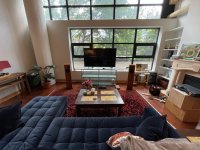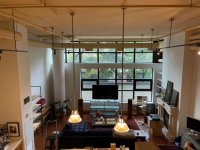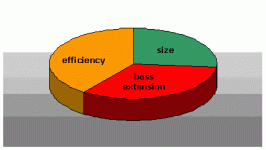"Elevating the Game" meant improvements based on the science that shows a flat response(among other things) adds less coloration recorded music, so in turn the sound is more natural and desirable. It's definitely the way I hear it.
I certainly don't doubt your listening preferences, just pointing out that not everybody shares them; what you consider to be an 'improvement' would for some people be the reverse.
Take my father. He's now in his late '70s, a lifelong music fan and former DJ, but he has no interest in hi-fi, and the 'natural and desirable' mentioned above, he would describe as boring, or lacking in body. What he wants from a speaker is 'good bass' and 'good tone'. For those, read 'a slightly elevated LF, and a relatively smooth midband response, on & off axis'. That's how he defines 'natural', and the kind of listening preferences / audience the R2.5 and speakers like it appeal to.
...I was trying to stress the point that One can't escape the audible effects of the box alignment.
Oh, I completely agree, because you're not supposed to escape it. Not entirely, it's a deliberate part of the design / voicing. The effect is reduced when they're well out from boundaries, but a rising LF response is built-in.
R2.5 was not a failure due to the fact that it was a commercial success!
Exactly. For all the thread title, it was actually a rather successful speaker which remained in production for about 6 or 7 years. Therefore, assuming no build errors, R2.5 clones don't really fail in themselves; they'll achieve more or less the same results as the production model. However, you can get an expectation mismatch, because some people want a different set of characteristics to those the speaker was designed to achieve.
Last edited:
I'm quite certain R2.5 design was deliberate! and people liked them and still do!
I'll leave it alone but after this:
If a person with R2.5(or clone) was Given the luxury to have a well integrated 2way speaker with equal low bass extension playing side by side, with the instantaneous ability to vary the box alignment and frequency response, for the purpose of trying to find a more desirable balance, would say - "Nope, Cant seem to find a better balance than I have with R2.5". This would be a mystery to me!
Do you feel R2.5 balance preference is cemented? The only way to know for certain if one has an ongoing preference for R2.5 balance is to gain more experience to see if it holds. I doubt anyone doing well designing speakers for personal use and who have owned R2.5 still have them.
Add In - this is about trying to help, not criticize
I'll leave it alone but after this:
If a person with R2.5(or clone) was Given the luxury to have a well integrated 2way speaker with equal low bass extension playing side by side, with the instantaneous ability to vary the box alignment and frequency response, for the purpose of trying to find a more desirable balance, would say - "Nope, Cant seem to find a better balance than I have with R2.5". This would be a mystery to me!
Do you feel R2.5 balance preference is cemented? The only way to know for certain if one has an ongoing preference for R2.5 balance is to gain more experience to see if it holds. I doubt anyone doing well designing speakers for personal use and who have owned R2.5 still have them.
Add In - this is about trying to help, not criticize
Last edited:
Old speakers are different after such agging, around 30 years and more for the P. 2.5 ?
If there is so much magic in the filter, it can be hard to know exactly what ECAXT capacitance value were used in the filter (20% precision of lytics and sometimes sorted out caps in some said high end speakers) . Then the T&S parameters also moved I assume. At least Qm factor (spider and surrounds) , perhaps also the cone stifness and way to break up the same.
I believe no one is remmembering exactly what was the true Sound of the P. 2.5 and from then can know if a fresh clone is a good one. Not saying there was a hype about Proac who aded a lot in hifi magazine... Most of consumers bought it trusting reviews word for word and get biased more than average -same for BW speakers and man brands that make live the hifi economy somewhat-
Certainly few doubt some models like this one was good, but how much ? And ad the personal bias focused on a brand name... well I know guy driving with old 911 which needs two ways road for driving straight, uh !
If there is so much magic in the filter, it can be hard to know exactly what ECAXT capacitance value were used in the filter (20% precision of lytics and sometimes sorted out caps in some said high end speakers) . Then the T&S parameters also moved I assume. At least Qm factor (spider and surrounds) , perhaps also the cone stifness and way to break up the same.
I believe no one is remmembering exactly what was the true Sound of the P. 2.5 and from then can know if a fresh clone is a good one. Not saying there was a hype about Proac who aded a lot in hifi magazine... Most of consumers bought it trusting reviews word for word and get biased more than average -same for BW speakers and man brands that make live the hifi economy somewhat-
Certainly few doubt some models like this one was good, but how much ? And ad the personal bias focused on a brand name... well I know guy driving with old 911 which needs two ways road for driving straight, uh !
If a person with R2.5(or clone) was Given the luxury to have a well integrated 2way speaker with equal low bass extension playing side by side, with the instantaneous ability to vary the box alignment and frequency response, for the purpose of trying to find a more desirable balance, would say - "Nope, Cant seem to find a better balance than I have with R2.5". This would be a mystery to me!
Well, there isn't a great deal of mystery: you're looking at it from the perspective of a DIYer. But the R2.5 was not a DIY project: it was a commercial product. It wasn't aimed at the majority of people who frequent this forum: it was sold to people who buy complete, finished loudspeakers they like the sound of, and that's about all there is to say about it on that front. It was, quite simply, an intelligently designed product with a particular set of characteristics that appealed to enough people to keep it in production for a good few years. That really is 'it'. Trying to read any more into it is a hiding to nothing. Assuming the finances and skills are available, as DIYers we have the opportunity of creating projects closely aligned to our individual requirements, but the point is that that is not generally possible in commercial hi-fi, where most products necessarily have their characteristics built-in, and are a case of 'you pays your money and you takes your choice'.
Last edited:
Well, there isn't a great deal of mystery: you're looking at it from the perspective of a DIYer. But the R2.5 was not a DIY project: it was a commercial product. It wasn't aimed at the majority of people who frequent this forum: it was sold to people who buy complete, finished loudspeakers they like the sound of, and that's about all there is to say about it on that front. It was, quite simply, an intelligently designed product with a particular set of characteristics that appealed to enough people to keep it in production for a good few years. That really is 'it'. Trying to read any more into it is a hiding to nothing. Assuming the finances and skills are available, as DIYers we have the opportunity of creating projects closely aligned to our individual requirements, but the point is that that is not generally possible in commercial hi-fi, where most products necessarily have their characteristics built-in, and are a case of 'you pays your money and you takes your choice'.
SAD!
SAD!
Come again? You appear to be stating that a purely factual post is incorrect (in which case you will need to explain how and why), or insulting people who do not share an interest in DIY audio.
Scan probably make more promising 7" drivers than the 18W-8535-00 these days, And you might ally it with a more generally capable 1" tweeter.
The 18W-8542-10 has a dip at 2.5kHz where the 18W-8535-00 had a more audibly troublesome peak:
A modern man will use the 18W-8542-10. And relieve it of extreme bass duties, which reduces distortion.
One must move with the times.
I have a failed 18W-8535 in my 2.5's and I am deciding if I desite to replace it. It would be a shame to dispose of these due to one failed Woofer.
Received an Exorbitant Price Quote from the USA ProAc Distributor so I have to ask;
If I replace Both Woofers I see that Madisound in the USA has them listed. I recognize they will not be speced by ProAc but I can get 2 in comparison to the price of 1 through the Distributor ($380 plus Shipping).
Will the 18W-8542-10 noted above work fine in the 2.5 without any other Mods?
If I proceed with this it is likely that I will have to desolder the existing Wire from the Terminals and use Female Spade connectors on the existing Wire. I am a little gun shy soldering the thickness of the existing Wire around a potentially $200.00 Woofer with my skill set.
Any other sources for the 18W-8535?
Thanks in advance.
I set up proac clones in a condo loft this past weekend. The approx dimensions are about 18'W,14'H,60'D - A very big space. The bass was less bloated then what I have ever heard from these speakers. Its the first time I enjoyed the bass quality from these speakers. IMO, clearly the appropriate size room for them..
Clones, fail or not, are a powerful compliment to the original designer. Whether you liked the originals or not, if you can get so many mfs trying to copy your design, you've done something quite special.
I personally really enjoyed my old ProAcs, kind of wish I still had them at times, RIP Stewart Tyler.
I actually have (pretty close to) the drivers here. Maybe my next project.
I personally really enjoyed my old ProAcs, kind of wish I still had them at times, RIP Stewart Tyler.
I actually have (pretty close to) the drivers here. Maybe my next project.
Joel,
That is a beautiful room, and very spacious.
I see a large carpet and a couch; beyond that have you considered any room treatment, and something on the ceiling?
Yes, we discussed treatments. Does this room need treatments? The boundaries are distant.
Any suggestions for treatments.. Diffusers mounted to the ceiling would look amazing. I know they would like that aesthetic.
I really don't see the need for acoustic treatment with those Proac cabinets .....
You say that you have noticed a big change when using them in that bigger environment, there are more defined bass, etc. You are at the limit. From now on, any treatment that is based on damping low frequencies will make them anemic to faithfully reproduce double basses, organs, etc.
You say that you have noticed a big change when using them in that bigger environment, there are more defined bass, etc. You are at the limit. From now on, any treatment that is based on damping low frequencies will make them anemic to faithfully reproduce double basses, organs, etc.
I set up proac clones in a condo loft this past weekend. The approx dimensions are about 18'W,14'H,60'D - A very big space. The bass was less bloated then what I have ever heard from these speakers. Its the first time I enjoyed the bass quality from these speakers. IMO, clearly the appropriate size room for them..
I listened to the originals in a small room and the owner was delighted by the sound.
But common sense and my experience, dealing with a low-liter BR with a small mid / woofer, led me to write the above.
Here is corroborated what I wrote previously regarding the low frequency response.
Proac 2.5 | pink fish media
( See post of Colin 131)
It is only physical.
" The bass response is usual like you say. There is a huge bass from the box size with a tendency towards midbass boom (so careful positioning is required).
Like I say the only issue is headroom. Play some bass heavy material at louder volumes in a larger room and the drivers will bottom out and you will hear it as a nasty buzzing sound. They used to market them somewhat for home cinema and they sound great as long as you don't want the volume too loud. No good for Organ music either. Real subbass stuff causes problems because the driver runs out of travel fast. "
Understand. Thanks academia50
Thinking more about diffusion designed at about 1khz and above on the ceiling. With the delay above 10ms , I'm curious how that would sound.
I wouldn't delay them, I don't think it will help, but I have to admit that I only use DSP to extend the response of my 40 Hz main cabinets down with two 18 "subwoofers ... I like to hear defined and clean bass, rich in harmonics and I think that there the relationship between the SD of the speakers and the size of the room matters, but up to a reasonable limit. This is the famous iron law of cabinets, you must choose two out of three, you can never have all of them to the time.
Attachments
- Home
- Loudspeakers
- Multi-Way
- Why do Proac 2.5 clones fail?


